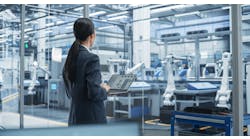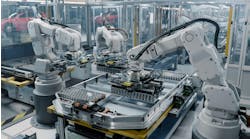Beckhoff packaging industry manager Mark Ruberg offers up his expertise
Last month, Beckhoff Automation hired Mark Ruberg as packaging industry manager in a move meant to strengthen its presence among U.S. packaging and processing OEMs and manufacturers of consumer packaged goods (CPGs). Ruberg now oversees sales efforts and application support for new and existing Beckhoff customers focused on the packaging and processing of goods across the U.S.
Beckhoff has accelerated the introduction of automation technologies for packaging applications in recent years, such as with the mechatronic eXtended Transport System (XTS).
Ruberg’s experience in packaging and plastics most recently involved serving as a regional sales manager for Conair Group and before that includes seven years at packaging machinery company ProMach.
(Source: Beckhoff North America)
Mark Ruberg answered 7 questions about the organization and how technology is affecting the industry.
What are three key things that a machine builder, system integrator or manufacturer should know about your company?
First, Beckhoff has based its automation platform on PC technology since the market entry of the first PC-based machine controller in 1986. PC Control continues to provide important technological momentum for manufacturers and machine builders across all industries. This is especially true for packaging, which has largely remained locked in traditional architectures for too long and is really starting to embrace revolutionary technologies.
Second, the EtherCAT industrial Ethernet system, which Beckhoff introduced in 2003, is still the fastest fieldbus in the automation world. Furthermore, Beckhoff has made EtherCAT technology open to the world as one of the founding members of the EtherCAT Technology Group (ETG). ETG has more than 5,500 member companies worldwide at the moment. EtherCAT’s distributed clocks, high speed and ability to support 65,535 devices on a single network allow for a truly deterministic fieldbus that has no limitations in terms system architecture.
Third, TwinCAT 3 automation software from Beckhoff turns the PC-based system into real-time controllers with many PLC, NC, CNC and robotic runtime solutions. Both the engineering environment and runtime execution reside in the universal TwinCAT software. Complete automation programming solutions are done within TwinCAT, including machine control logic, motion control, HMI, TwinSAFE integrated safety, high-end measurement technology, condition monitoring, image processing/vision, machine learning and more. TwinCAT supports all IEC 61131-3 programming languages, ladder logic, structured text, function blocks, object-oriented programming, PackML, C++ and MATLAB/Simulink. Optimized for 64-bit operating systems, TwinCAT future proofs applications and supports multi-core and many-core CPUs.
What new technologies are driving your product development and why?
OEMs and end users continue to develop data-driven initiatives to empower continuous improvement efforts and productivity gains. Data analytics deliver actionable information, but this new information age in automation is really still in its early stages.
The data needs of machine builders and manufacturers have driven Beckhoff to extend EtherCAT’s record speeds by announcing EtherCAT G and EtherCAT G10, which will offer communication rates of 1 Gbit/s and 10 Gbit/s, respectively. On the software side, the algorithms for condition monitoring, predictive maintenance, analytics and machine learning are being realized now and will continue to evolve. These technologies are data intensive, but combined with the exceptional bandwidth increases of EtherCAT G, they will unlock productivity gains that deliver dramatic increases in OEE.
How does the Industrial Internet of Things figure in your business strategy?
I feel that Industry 4.0 is more comprehensive than IIoT. The initiative is integral with our product development. Industry 4.0 cohabitates with the world in which our products reside. Of course, big data is only meaningful if analytics deliver actionable intelligence. Beckhoff’s people and products are fundamentally familiar with operations, creating a deep understanding of production realities. This understanding positions Beckhoff to deliver on the promises of advanced analytics.
How will machine automation and controls alter the way companies staff their operations in the future?
Companies must rethink their target audience and job descriptions. The most disruptive technologies (for example, self-driving cars, drones, robots/cobots, automation, augmented reality, artificial intelligence and so on) are training amazing programmers in new methods that more traditional automation specialists might not consider. Controlling the machine is only a portion of the control needs. Smart factories require communication horizontally up and down production lines as well as communications vertically with business enterprise systems. Companies are rapidly exiting the server business and moving to cloud-based solutions.
So where do companies look for automation, controls and operations programmers? For example, consider more IT-oriented programmers who know C, C++, object-oriented programming and abstraction layers. These approaches are far more common in most current university curricula than ladder logic programming. We find that some IT students and gamer types get extremely excited when introduced to automation technology only after they see that their software programs can actually manipulate and control real-world objects.
How is the development of software solutions impacting your requirements for hardware?
Beckhoff recently introduced the eXtended Transport System (XTS) to the U.S. market. This mechatronic system creates design flexibility that allows engineers to consider solutions previously not possible. Machine vision, image processing and machine learning software solutions are being introduced into the TwinCAT engineering environment. TwinCAT 3 provides expansion capabilities to protect our customers’ intellectual property in the dynamically changing technology world.
These technologies require controls and industrial networking to handle much greater amounts of data. EtherCAT has held its position as the fastest fieldbus in the market since 2003. Now EtherCAT G and G10 provide even more bandwidth to handle the increasing data needs created by technological advances in vision systems and the most demanding motion control applications. Most importantly, these are fully compatible extensions that will integrate into standard EtherCAT networks with an innovative branch controller model, rather than replace them. EtherCAT is and will continue to be on protocol version 1.0.
As engineering and IT continue their convergence, which one is and/or will be leading the direction of future automation and technology at your organization?
Historically, business functions have been classified into departmental areas — IT, OT, engineering, accounting, sales and marketing, for example. This model resulted in “over the wall” issues, territorial conflicts and power struggles. The information age blurs the lines between departments while promoting collaboration through better data. Data-driven organizations will test the leadership skills of upper management, more than ever before, to align resources and rewards for achieving the organization’s desired outcomes.
Looking into the future, how will technology change your company over the next five years?
Among the many advances Beckhoff is bringing to manufacturers and OEMs, we can envision machines without control cabinets by utilizing smart HMIs, distributed and machine mounted I/O, motors with integrated drives and One Cable Technology (OCT). Moore’s Law continues to hold true, which gives PCs increasing power to control multiple machines or entire lines.
After 40 years in the machinery business, I have little doubt that nearly everything that we can imagine today can be realized in the future. Embracing STEM education and revolutionary technologies is the only path for future success. Evolution or extinction is the choice. At Beckhoff, there are unprecedented levels of resources directed towards research and development so we can ensure our customers thrive today and in the future.
Control Design Newsletters
Latest from Vertical Industries

Leaders relevant to this article:





